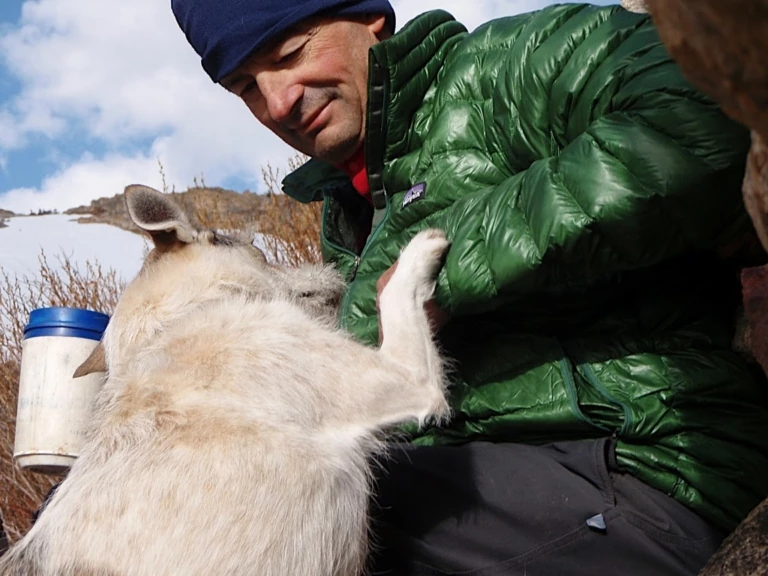How to Wash and Care for Your Down Jacket
A lot of people are afraid to wash and dry their down jacket. Turns out, it’s not much harder than washing a pair of jeans.
Like flocks of swirling swallows or shimmering schools of tropical fish, our customers swoop in with mysteriously synchronized concerns and questions on a regular basis, prompting the need for ready answers. Times like these, nothing would be more handy than magically beaming knowledge out into the ether. Our very own Old School is here to do just that. He’s stepped back from the front lines of Patagonia Customer Service to answer some of these more popular questions.

How Do I Wash My Down Jacket?
Perhaps it due to all the warnings about the perils of wet down, but it seems a lot of people are afraid to wash their down jacket. Down is remarkably tough stuff and though wet down has virtually zero insulation properties, getting it wet doesn’t hurt it in the least. Washing a down jacket is not much harder than washing a pair of jeans. There are three things you’ll need to wash your down jacket: down soap, a front-load washer, and a dryer with reliably low heat.
Step 1: Use Down Soap
While you can use regular detergents, they can strip away the natural oils in down and don’t always rinse out cleanly so I recommend using a cleaner specifically designed for down. I find NikWax® Down Wash works really well but there are several other effective down cleaners on the market.
Step 2: Put the Down Jacket in a Front-Load Washer
Next, try to find a front-loading washer. If you can’t find one, a top loader on the gentle cycle will suffice. We’ve heard of instances where even the gentle cycle ripped or snagged the fabric so we recommend front loaders. If you’re washing a thick down jacket, a down parka or most any down sleeping bag there’s no choice, you must use a front loader. This is because most sleeping bags and many jackets use a box wall construction (for a great explanation of the various baffle designs, go here) that are easily ripped by the agitating action of top loaders. If you’re looking to ruin your jacket or sleeping bag, washing it incorrectly is an easy way to do it.
If your garment has really dirty spots, (like cuffs or the neck) you can spray fabric stain remover on these areas before washing. Use the permanent press cycle on the washer and add the proper amount of soap per directions on the bottle. Don’t add more than necessary because residual soap prevents items from lofting completely. If your garment is really dirty you can also stop the washer mid-wash for a hour or so and let it soak. To ensure all residual soap is rinsed out, run it through an additional wash cycle with no soap at all.
Step 3: Dry the Down Jacket on Low Heat
Now comes the important part, drying it. Drying a down jacket is a slow process so be prepared to spend some time at home. It’s also a delicate business, high heat can ruin your down jacket but you need some heat or drying takes forever. On a home dryer, low heat works best. Be extremely careful if you’re at a laundromat! These dryers often get incredibly hot even on low heat so check the dryer carefully before throwing in your jacket. Tossing in a few clean tennis ball will help break up the down clumps and hasten the drying process. Even with the tennis balls it’s a good idea to pull the jacket out of the dryer periodically and manually pull apart the clumps with your fingers. An entire baffle’s worth of down can be a clump the size of a marble so pulling them apart dramatically speeds up drying. If you don’t have a dryer and the one at your local laundromat seems hot enough to melt glass you can always air dry them. This can take anywhere from a couple days to more than a week, depending on humidity, but it’s actually the safest way to dry it. To air dry it, lay it flat on a towel in a warm dry spot out of direct sunlight. Just make sure to pull apart the clumps periodically and to flip it over occasionally or it will really take a long time.
However you choose to dry your garment, make sure it’s completely dry before stuffing or packing it. Because down absorbs so much water it looks and feels dry long before it really is. While it’s never a good idea to store a down product stuffed, it’s doubly important to not store wet down stuffed. Stuffing wet down is the perfect recipe for mildew which will present you with yet another excellent way to ruin both the down and the jacket.

Above: Down jackets (and jeans!) were all the rage back in 1976 as well. Old School and Jon Rose atop Mount Hood, Oregon. Photo: Old School
Dry Cleaning a Down Jacket
I can’t write about washing down without mentioning dry cleaning. Due to the harshness of dry cleaning chemicals, we don’t recommend dry cleaning for any of our products. In theory, down can be dry cleaned by a reputable dry cleaner experienced with down. I say in theory because I once took a sleeping bag to a dry cleaner that claimed it “cleaned down all the time.” My bag came back clean as a whistle and flat as a pancake. My advice: Wash it yourself.
How to Fix Small Holes in Down Jackets
Down sweaters and jackets are incredibly popular insulation pieces and for good reason: They’re warm and so comfortably light you almost forget you’re wearing one. Unfortunately, there is a downside (so to speak) to their being so light. Most down sweaters and jackets use lightweight fabrics to keep the garment light and packable. They’re designed to be worn around camp or around town but aren’t the best choice for activities like downhill skiing or hiking where there’s a good chance of catching the jacket on something sharp. If you’re the type who likes to do just that, I highly recommend wearing a shell over your jacket, especially if you’re hiking through brush or skiing the trees.

Above: Sharp dog claws are another popular way to tear your down sweater. Skeena and Old School, East Humboldts, Nevada. Photo: localcrew
Even if you’re not picking your way through snowbush, down garments seem to have an affinity for sharp, pointy things so there’s always a chance that you might end up with a small tear in the shell fabric. So what to do? While many dirtbags proudly patch their clothes with duct tape, it’s not really the best option, especially if you want to fix it later (the residual glue causes havoc with sewing machines.). Instead, head to your local mountain shop and pick up some nylon repair tape, also known as down jacket repair patches. Just about any shop should have a selection in lots of pretty colors. Pick the closest color and then cut a piece at least ½” bigger around than the hole, round off the corners, peel off the backing and stick it on. That’s it. This tape is pretty amazing stuff and it will last for years through many washings. Repair tape is a super easy fix for small holes in the shell fabric but with larger rips it’s probably best to send it back to us for service.
For more DIY tips, visit our Care & Repair page.
